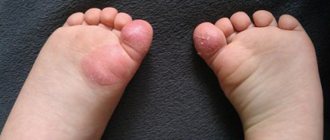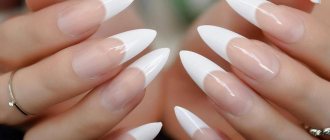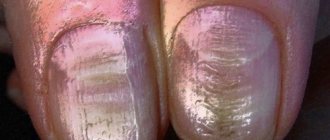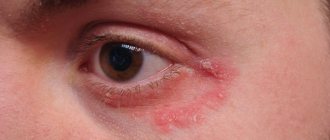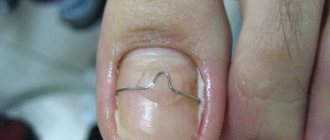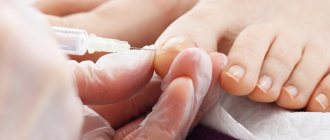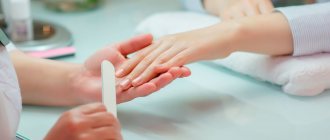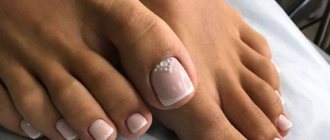Separation of the nail from the nail bed on the foot is a pathology that may indicate a bacterial, viral or fungal infection. Most often this happens when hygiene rules are not followed after visiting public places with high humidity. In addition, detachment can begin due to severe vitamin deficiency, chronic diseases of internal organs and after nail injuries. You can get rid of this problem with the help of medications and folk remedies.
Why does the nail peel off?
There are many factors that provoke the development of onycholysis. The separation of the nail plate could be caused by:
- The nail on the thumb is moving away from the skin.
Injury to the phalanx of the finger or the stratum corneum. Damage could occur due to mechanical or chemical influence. As a result of an impact, strong pressure or burn, the vital activity of cells is disrupted, tissue necrosis occurs and the nail peels off. - Walking in tight shoes. If the thumbs are constantly in a compressed state, blood circulation is disrupted, nutrition of the horny plate deteriorates, and tissue rejection occurs.
- Poor quality pedicure. Injury can result from careless sharpening or careless cutting of the nail.
It's possible that it's not just your big toenails that are peeling, but several of your toenails at once. The cause of this pathology may be:
Psoriasis of toenails
- Dermatological diseases - eczema or psoriasis of the stratum corneum.
- Long-term use of tetracycline and fluoroquinolone antibiotics.
- Chronic diseases of the cardiovascular, endocrine, nervous or digestive systems that affect the condition of the nails.
- Fungal infection of the feet, localized on the horny plate.
Most often, toenails detach from the skin due to a parasitic fungus. Before treating an infection, you need to find out what pathogen is causing it.
Prevention
If the cause of the disease is injury or an infectious disease, then it is impossible to prevent the occurrence of a fungal infection. Otherwise, by adhering to simple rules , you can protect yourself from the occurrence of unpleasant diseases and their consequences:
- You must follow the rules for visiting swimming pools, saunas or fitness centers.
- Before a manicure or pedicure, you must disinfect your instruments.
- Chronic diseases should not be allowed; they can cause yellowing of nails.
Symptoms of onycholysis
As a rule, detachment is painless. This often makes it difficult to notice the initial signs of the disease. Be attentive to yourself, then you will not miss the first call. Incipient onycholysis makes itself felt with the following symptoms:
- Change in color of the nail on the big toe after an injury,
the border line between the white and pink parts of the nail plate begins to bulge and becomes uneven; - the nail completely or partially changes its usual color to blue, yellow or white. With an impact and a hematoma, the horny covering may turn black (see photo of a hematoma on the big toe);
- the nail plate thickens;
- nail growth stops.
When the connection between the stratum corneum and the soft tissues is disrupted, voids form under the nail. The pathological process can cover the entire area of the nail plate and end in complete rejection. Outwardly it looks untidy; Therefore, it is important to diagnose the development of onycholysis in time.
Signs of onycholysis
What to do at the first signs of the disease? The right decision would be to visit a doctor. Fungus, psoriasis, and eczema are treated by a dermatologist; examination by a more specialized specialist, a mycologist, is possible.
Important! If the doctor confidently diagnoses a fungal disease during a visual examination, look for another specialist. It can only be stated that the cause of damage to the stratum corneum is a fungus after appropriate tests have been carried out.
If the nail detachment began after an injury, you will need to consult a surgeon.
How is the diagnosis done?
The lesion may affect just one finger, several fingers, or all of them at once. This symptom is important for diagnosis, as it suggests the cause of dystrophy. If only one finger is injured, then most likely it is due to injury. If there are several, there are systemic violations.
The diagnosis is made by a dermatologist or podologist. First, inspects the problem area. Then, to find out the cause, he clarifies: whether the person has suffered viral infections over the past two months, what medications he took, whether there were any injuries, whether there are skin diseases. If necessary, prescribe a study of scraping the plate for fungus, a blood test for viral infections, autoimmune, systemic, and inflammatory diseases.
Drug treatment
The choice of therapy will depend on the primary causes of the problem. In case of traumatic damage, it is enough to keep the nail clean, treat it with antiseptic agents, carefully trim it and wait for a new plate to grow.
For systemic diseases, local treatment is ineffective: an integrated approach is required to eliminate or reduce relapses of the underlying disease. If the nail moves away from the nail bed after taking antibiotics, the condition will return to normal after stopping the drugs. As the healthy nail grows, the damaged part will be pushed out.
The most difficult thing to achieve is the treatment of fungal infections. It takes a lot of time - from several months to several years. The doctor will prescribe you antifungal chemotherapy drugs. Complex treatment includes oral antimycotics:
Toenail fungus
- Fluconazole;
- Intracanazole;
- Ketoconazole;
- Griseofulfin.
Also used for external use:
- Clotrimazole;
- Bifonazole;
- Ciclopirox in the form of varnish, cream or solution;
- Oxytetracycline ointment;
- Terbinafine and other medications at the discretion of the treating healthcare professional.
To improve microcirculation and ensure the supply of nutrients to the nail bed, the doctor will prescribe massage or physiotherapeutic procedures. He will also prescribe strengthening vitamin complexes and preparations containing active calcium ions. This element is necessary to strengthen the nail plate.
What is onychomadesis
Onychomadesis is a disease of the nail plate, during which a change in the structure of the nail occurs, followed by its detachment. With timely treatment, the progression of the disease can be stopped.
Onychomadesis can appear on several fingers; most often this type of problem appears on the lower extremities.
The nail plate at the site of the lesion changes its color and gradually acquires a yellow and then a dark tint. Lack of treatment contributes to poor circulation, which can result in the nail peeling off completely.
Treatment with folk remedies
There are various solutions to improve the health of the stratum corneum at home. It is unlikely that it will be possible to cure a diseased nail using folk recipes; these procedures can be considered as an adjuvant to drug therapy. Comprehensive measures will help stop the process of onycholysis. You can prepare medicinal baths, lotions, mixtures for rubbing into the affected area:
- Mix freshly squeezed juice of one orange with 1 tbsp. l. salt, 4-5 drops of iodine and 50 ml of mineral water at room temperature. Keep your fingers in this solution for 10-15 minutes. This recipe is suitable when nail detachment and void formation are in the initial stages.
- Add apple cider vinegar or hydrogen peroxide to warm water in a 2:1 ratio. This bath is effective when the toenail is completely separated from the toe. Do it 2 times a day for 20 minutes.
- Add 0.5 tsp. gelatin in 200 g of water and let it brew for 30 minutes. Then heat the solution and immerse the damaged nail in it for 15 minutes. Repeat the procedure every other day until the condition of the plate improves.
- Steam 1 tbsp with a glass of boiling water. l. dry pharmaceutical chamomile and pine needles. Let it brew for 30 minutes, then strain and combine with green tea (1:1). Take the bath for half an hour, repeat the procedure every day.
- Use iodine. Apply a thin layer of it to the affected part before going to bed. Do this for several days in a row - 1-2 weeks.
- Prepare a mixture of crushed garlic and butter. Take the ingredients in equal proportions. Rub the product into the sore nail. Repeat the procedure every day or every other day until positive results are achieved.
- It is very useful to rub sea buckthorn or olive oil into the damaged nail before going to bed.
Before applying various compounds to the stratum corneum, the surface to be treated should be steamed and cleaned of contaminants.
Nail removal
In particularly advanced cases, when the infection is severe or the nail has almost completely come away from the skin, the doctor may recommend surgery to amputate the horny plate. The procedure is painful and is performed under local anesthesia. During the recovery period, therapeutic bandages are applied to the finger using antibacterial agents.
There is a chemical way to remove damaged nails. It is based on the use of keratolytic components that dissolve the horny part. You can purchase drugs such as Nogtimycin, Nogtevit at the pharmacy and, following the instructions, remove the nail yourself.
Removing a nail with a pedicure machine
You can also get rid of the nail plate when it peels off using a hardware pedicure or laser (see photo of big toe nail removal). Find out if this procedure is performed at your nearest cosmetology clinic. Within 2-3 months, a new nail will begin to grow, and if you have eliminated the root cause of the disease, you can guarantee that it will be healthy.
To quickly restore the stratum corneum, it is recommended to take a gelatin solution. Pour in 2 tsp. edible gelatin 100 g of warm water and leave to swell. Then heat the solution in a water bath, add another 100 g of water. When the crystals are completely dissolved, add 1 tsp. lemon juice and drink. Drink gelatin an hour before meals in the morning for 2 weeks. Then they take a break for a week and repeat the course again.
Stages of onychomadesis
The disease can occur in several forms: it is partial and complete damage to the nail plate.
Also, onychomadesis can manifest itself in various stages:
- Development of the disease - minor symptoms of the disease appear. Most often in the form of small light spots on the nail plate. The disease is quickly treatable and does not cause discomfort for the patient.
- Stable progression - onychomadesis is manifested by symptoms such as brittleness and damage to the nails. Symptoms do not increase; when using medications, the necessary therapeutic result is absent.
- Subsidence of the disease - manifested by minor symptoms that disappear on their own or after the use of medications.
- Regressive stage , which tends to reduce the intensity of symptoms, but after a short time it manifests itself with renewed vigor. Most often it manifests itself in diseases of internal organs.
- Recovery – the symptoms of the disease reduce in intensity, the nail acquires a healthy appearance.
A specialist will be able to correctly determine the stage of development of onychomadesis after conducting the necessary type of diagnosis.
Preventive measures
The following preventive measures will help prevent the development of onycholysis:
- regularly monitor foot hygiene;
- try not to injure your nails (for example, when performing repair and construction work, wear closed shoes or sneakers);
- to avoid fungal infection, do not wear someone else’s shoes;
- avoid direct contact with chemicals;
- trim the overgrown part of the nail plate in a timely manner;
- don’t get carried away with nail extensions;
- do not buy tight shoes;
- keep your feet dry, avoiding high humidity;
- Treat chronic diseases in a timely manner.
By following these recommendations, you will maintain healthy nails.
Lack of vitamins
Deficiency of vitamins and various macro- and microelements can also provoke detachment of the nail plate. Their deficiency usually occurs when eating poor food.
The diet must contain foods high in iron, calcium, and zinc . large amounts of magnesium, vitamin D, and phosphorus is ideal , without which calcium absorption is impossible.
B, A and E , found in apples, butter and sunflower oil, seeds, dairy products, and nuts, are also important for healthy nails
Also in the diet there should be the presence of protein products, vegetables and fruits containing silicon, amino acids, zinc and folic acid.


